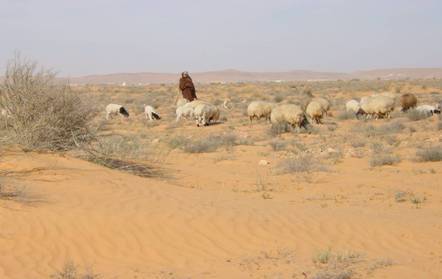Agricultural sector
The place occupied by the agricultural sector in the province of Médenine can be determined by the importance of the annual income generated by this sector. which reached (1994 data) 116 million dinars as well as the percentage of the labour affected to this sector which reached at the same year 19% of the active population. This rate is, however, in continuous decline passing from 26.6% in 1989 to 21.6% in 1994 (MEAT, 1998). This sector is confronted with certain problems, like desertification, scarcity of water, the marginalization of pasture lands. The productivity of certain cropping species remains low and variable and not very competitive. The agricultural production is, in all cases, highly depending of the climatic conditions. Nevertheless, agriculture still represents an important sector with twofold dimensions; economic and socio-cultural. It represents a source of subsistence and production of richness and management of risks, on one hand, and a cultural and patrimonial reference, on the other hand.
The traditional production systems combined the concentration of the production inputs on limited areas and the extensive exploitation of pastoral resources. During the last forty years, a rapid evolution of the production systems has taken place and it was marked by the exploitation of the natural resources, particularly the increased use of ground water resources by drillings for the extension of irrigated fields and the agro-food industries, as well as the extension of arboriculture in the coastal areas because of land property transfers. In this context, the spatial agrarian complementary systems disappeared and were replaced by inter-connected production systems whose dynamic is expressed by a competition for the access to natural resources and especially towards water (IRA, IRD, 2003). The farming systems are marked by their diversity from the upstream to downstream areas. These systems are essentially distinguished by: 1) a non regular agricultural production that varies from one year to another depending on the rainfall regime, 2) the development of fruit trees orchards and the extension of newly cultivated fields at the expense of rangelands, 3) the gradual transformation of the livestock husbandry systems from an extensive mode, highly dependent on the natural grazing lands, to an intensive mode, 4) the development of the irrigated agriculture exploiting the shallow and deep groundwater aquifers of the region, and 5) the predominance of olive trees (almost 90 %) and the development of episodic cereals. The main encountered farming systems are: System of "Jessour", system of irrigated perimeters, system of olive trees, and system of multicrops - breeding. Arboriculture represents the main agricultural activity in the area. The olive-tree is the main species cultivated in row cropping with other trees (fig, almond) on the terraces of the water harvesting structures. The olive-growing production dominates almost the totality of the agricultural production in the various geophysical zones of the watershed area.
The pasture lands, which represent the main support of the breeding sector, cover 187,507 ha in the Zeuss-Koutine regions, that is 3 % of the national rangelands. According to the livestock census 2000 the livestock is made up of 98,800 heads of sheep, 60400 heads of goats 1,150 heads of camels. The herd consists on average of 8.5 sheep, 4.59 goats 1.95 camels. This number varies largely from one site to another (Sghaier et al., 2003).

Livestock is an important activity but overgrazing may lead to desertification.